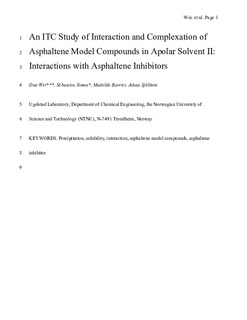| dc.contributor.author | Wei, Duo | |
| dc.contributor.author | Simon, Sebastien Charles | |
| dc.contributor.author | Barriet, Mathilde Isabelle | |
| dc.contributor.author | Sjøblom, Johan | |
| dc.date.accessioned | 2018-01-23T11:27:09Z | |
| dc.date.available | 2018-01-23T11:27:09Z | |
| dc.date.created | 2016-12-02T14:31:41Z | |
| dc.date.issued | 2016 | |
| dc.identifier.citation | Colloids and Surfaces A: Physicochemical and Engineering Aspects. 2016, 495 87-99. | nb_NO |
| dc.identifier.issn | 0927-7757 | |
| dc.identifier.uri | http://hdl.handle.net/11250/2479022 | |
| dc.description.abstract | The interaction and complexation of asphaltene model compounds containing functional groups with other crude oil compounds in a mixture of xylene and heptane have been studied to shed new light on the association and interaction between components in the asphaltene fraction and with asphaltene inhibitors. The model compounds are N-(1-undecyldodecyl)-N′-(5-carboxylicpentyl)perylene-3,4,9,10-tetracarboxylbisimide (C5PeC11) and N,N′-bis(1-undecyldodecyl)perylene-3,4,9,10-tetracarboxylbisimide (BisAC11).
C5PeC11 has a very low solubility limit in a mixture of 70 vol% heptane/30vol% xylene. This solubility is increased by the presence of BisAC11 most likely due to the formation of a soluble (BisAC11)(C5PeC11) complex. The association constant of this complex is found to be ≈700 corresponding to a ΔG of ≈–16 kJ/mol. The interaction between model compounds and model asphaltene inhibitors, nonylphenol (NP) and dodecyl benzene sulfonic acid (DBSA), have been investigated as well by isothermal titration calorimetry (ITC). Compared to NP, DBSA can interact more strongly with C5PeC11 through a combination of hydrogen bonding and π–π stacking. DBSA can also enhance the solubility of C5PeC11 more efficiently than BisAC11 due to (DBSA)(C5PeC11) complex formation. The calculated association constant of this complex is ≈8·53 × 103 which corresponds to a ΔG of −22.4 kJ/mol. | nb_NO |
| dc.language.iso | eng | nb_NO |
| dc.publisher | Elsevier | nb_NO |
| dc.rights | Attribution-NonCommercial-NoDerivatives 4.0 Internasjonal | * |
| dc.rights.uri | http://creativecommons.org/licenses/by-nc-nd/4.0/deed.no | * |
| dc.title | An ITC study of interaction and complexation of asphaltene model compounds in apolar solvent II: Interactions with asphaltene inhibitors | nb_NO |
| dc.type | Journal article | nb_NO |
| dc.type | Peer reviewed | nb_NO |
| dc.description.version | acceptedVersion | nb_NO |
| dc.source.pagenumber | 87-99 | nb_NO |
| dc.source.volume | 495 | nb_NO |
| dc.source.journal | Colloids and Surfaces A: Physicochemical and Engineering Aspects | nb_NO |
| dc.identifier.doi | 10.1016/j.colsurfa.2016.01.052 | |
| dc.identifier.cristin | 1407715 | |
| dc.relation.project | Norges forskningsråd: 234112 | nb_NO |
| dc.description.localcode | © 2016. This is the authors’ accepted and refereed manuscript to the article. Locked until 1.2.2018 due to copyright restrictions. This manuscript version is made available under the CC-BY-NC-ND 4.0 license http://creativecommons.org/licenses/by-nc-nd/4.0/ | nb_NO |
| cristin.unitcode | 194,66,30,0 | |
| cristin.unitname | Institutt for kjemisk prosessteknologi | |
| cristin.ispublished | true | |
| cristin.fulltext | original | |
| cristin.fulltext | postprint | |
| cristin.qualitycode | 1 | |

